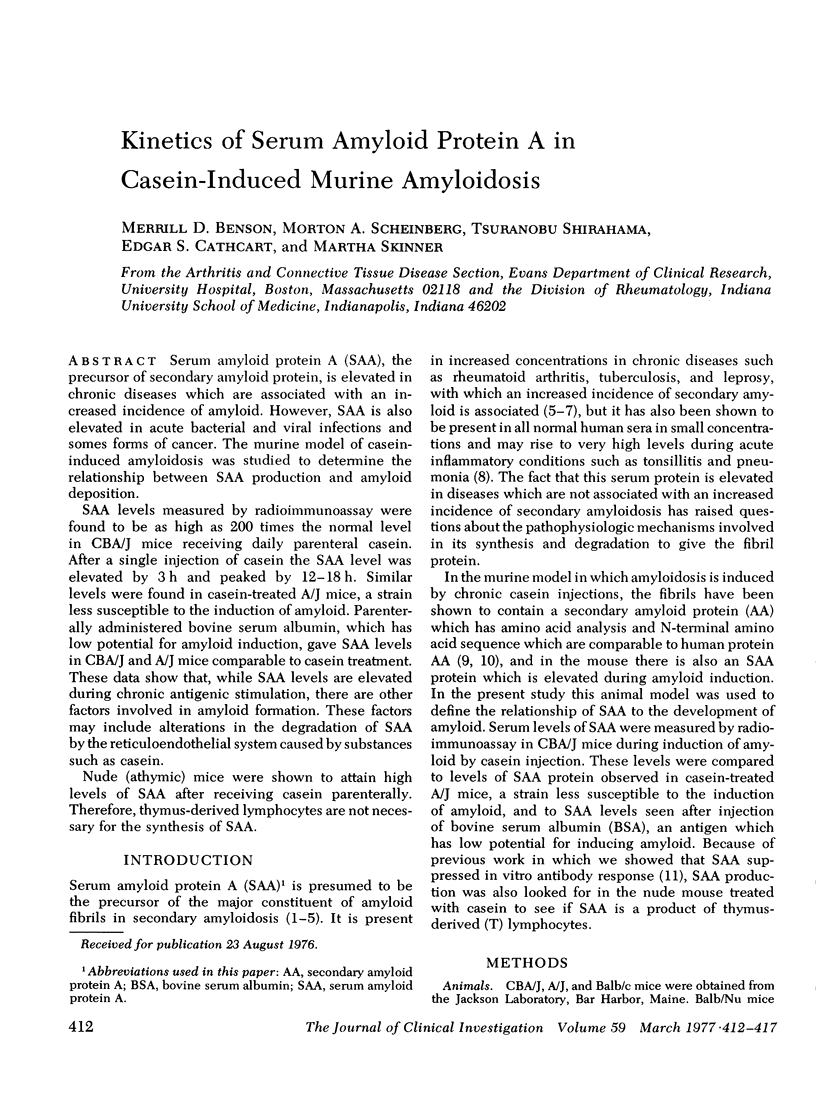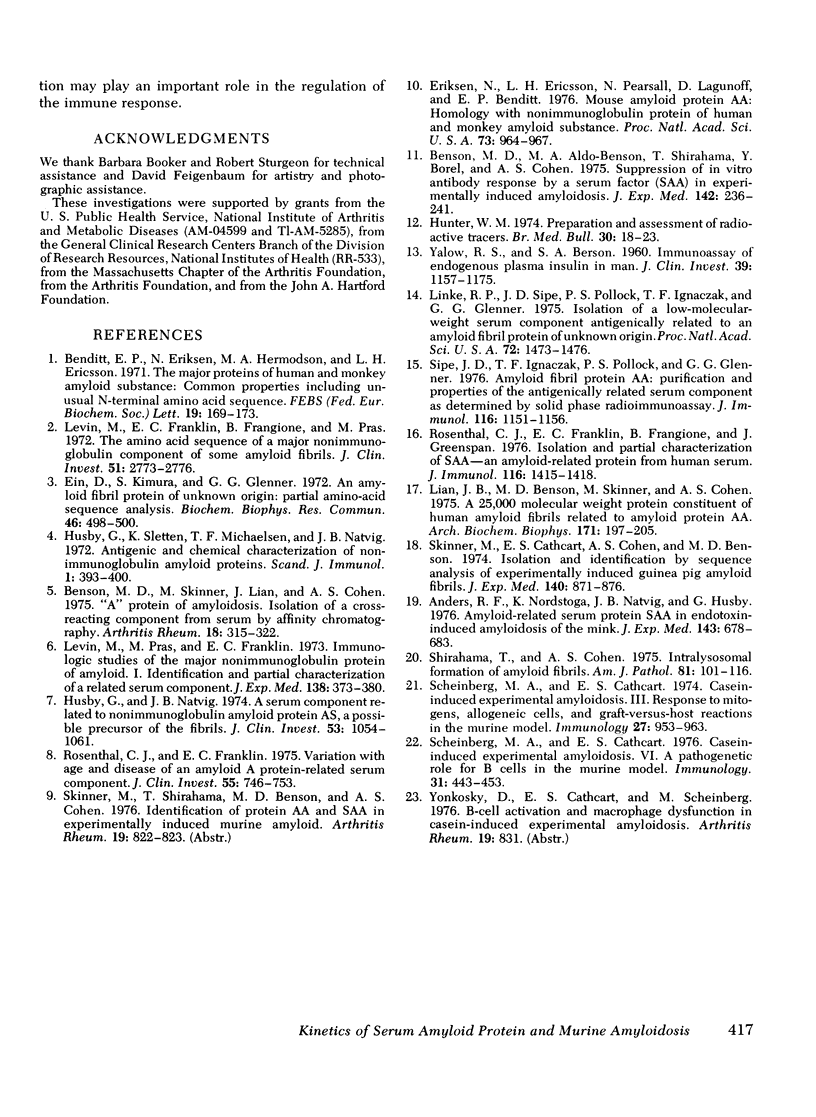Abstract
Serum amyloid protein A (SAA), the precursor of secondary amyloid protein, is elevated in chronic diseases which are associated with an increased incidence of amyloid. However, SAA is also elevated in acute bacterial and viral infections and somes forms of cancer. The murine model of casein-induced amyloidosis was studied to determine the relationship between SAA production and amyloid deposition. SAA levels measured by radioimmunoassay were found to be as high as 200 times the normal level in CBA/J mice receiving daily parenteral casein. After a single injection of casein the SAA level was elevated by 3h and peaked by 12-18 h. Similar levels were found in casein-treated A/J mice, a strain less susceptible to the induction of amyloid. Parenterally administered bovine serum albumin, which has low potential for amyloid induction, gave SAA levels in CBA/J and A/J mice comparable to casein treatment. These data show that, while SAA levels are elevated during chronic antigenic stimulation, there are other factors involved in amyloid formation. These factors may include alterations in the degradation of SAA by the reticuloendothelial system caused by substances such as casein. Nude (athymic) mice were shown to attain high levels of SAA after receiving casein parenterally. Therefore, thymus-derived lymphocytes are not necessary for the synthesis of SAA.
Full text
PDF





Selected References
These references are in PubMed. This may not be the complete list of references from this article.
- Anders R. F., Nordstoga K., Natvig J. B., Husby G. Amyloid-related serum protein SAA in endotoxin-induced amyloidosis of the mink. J Exp Med. 1976 Mar 1;143(3):678–683. doi: 10.1084/jem.143.3.678. [DOI] [PMC free article] [PubMed] [Google Scholar]
- Benditt E. P., Eriksen N., Hermodson M. A., Ericsson L. H. The major proteins of human and monkey amyloid substance: Common properties including unusual N-terminal amino acid sequences. FEBS Lett. 1971 Dec 1;19(2):169–173. doi: 10.1016/0014-5793(71)80506-9. [DOI] [PubMed] [Google Scholar]
- Benson M. D., Aldo-Benson M. A., Shirahama T., Borel Y., Cohen A. S. Suppression of in vitro antibody response by a serum factor (SAA) in experimentally induced amyloidosis. J Exp Med. 1975 Jul 1;142(1):236–241. doi: 10.1084/jem.142.1.236. [DOI] [PMC free article] [PubMed] [Google Scholar]
- Benson M. D., Skinner M., Lian J., Cohen A. S. "A" protein of amyloidosis. Isolation of a cross-reacting component from serum by affinity chromatography. Arthritis Rheum. 1975 Jul-Aug;18(4):315–322. doi: 10.1002/art.1780180404. [DOI] [PubMed] [Google Scholar]
- Ein D., Kimura S., Glenner G. G. An amyloid fibril protein of unknown origin: partial amino-acid sequence analysis. Biochem Biophys Res Commun. 1972 Jan 31;46(2):498–500. doi: 10.1016/s0006-291x(72)80166-9. [DOI] [PubMed] [Google Scholar]
- Eriksen N., Ericsson L. H., Pearsall N., Lagunoff D., Benditt E. P. Mouse amyloid protein AA: Homology with nonimmunoglobulin protein of human and monkey amyloid substance. Proc Natl Acad Sci U S A. 1976 Mar;73(3):964–967. doi: 10.1073/pnas.73.3.964. [DOI] [PMC free article] [PubMed] [Google Scholar]
- Hunter W. M. Radioimmunoassay and saturation analysis. Preparation and assessment of radioactive tracers. Br Med Bull. 1974 Jan;30(1):18–23. doi: 10.1093/oxfordjournals.bmb.a071161. [DOI] [PubMed] [Google Scholar]
- Husby G., Natvig J. B. A serum component related to nonimmunoglobulin amyloid protein AS, a possible precursor of the fibrils. J Clin Invest. 1974 Apr;53(4):1054–1061. doi: 10.1172/JCI107642. [DOI] [PMC free article] [PubMed] [Google Scholar]
- Husby G., Sletten K., Michaelsen T. E., Natvig J. B. Antigenic and chemical characterization of non-immunoglobulin amyloid proteins. Scand J Immunol. 1972;1(4):393–400. doi: 10.1111/j.1365-3083.1972.tb03305.x. [DOI] [PubMed] [Google Scholar]
- Levin M., Franklin E. C., Frangione B., Pras M. The amino acid sequence of a major nonimmunoglobulin component of some amyloid fibrils. J Clin Invest. 1972 Oct;51(10):2773–2776. doi: 10.1172/JCI107098. [DOI] [PMC free article] [PubMed] [Google Scholar]
- Levin M., Pras M., Franklin E. C. Immunologic studies of the major nonimmunoglobulin protein of amyloid. I. Identification and partial characterization of a related serum component. J Exp Med. 1973 Aug 1;138(2):373–380. doi: 10.1084/jem.138.2.373. [DOI] [PMC free article] [PubMed] [Google Scholar]
- Lian J. B., Benson M. D., Skinner M., Cohen A. S. A 25,000 molecular weight protein constituent of human amyloid fibrils related to amyloid protein AA. Arch Biochem Biophys. 1975 Nov;171(1):197–205. doi: 10.1016/0003-9861(75)90024-7. [DOI] [PubMed] [Google Scholar]
- Linke R. P., Sipe J. D., Pollock P. S., Ignaczak T. F., Glenner G. G. Isolation of a low-molecular-weight serum component antigenically related to an amyloid fibril protein of unknown origin. Proc Natl Acad Sci U S A. 1975 Apr;72(4):1473–1476. doi: 10.1073/pnas.72.4.1473. [DOI] [PMC free article] [PubMed] [Google Scholar]
- Rosenthal C. J., Franklin E. C., Frangione B., Greenspan J. Isolation and partial characterization of SAA-an amyloid-related protein from human serum. J Immunol. 1976 May;116(5):1415–1418. [PubMed] [Google Scholar]
- Rosenthal C. J., Franklin E. C. Variation with age and disease of an amyloid A protein-related serum component. J Clin Invest. 1975 Apr;55(4):746–753. doi: 10.1172/JCI107985. [DOI] [PMC free article] [PubMed] [Google Scholar]
- Scheinberg M. A., Cathcart E. S. Casein-induced experimental amyloidosis. III. Response to mitogens, allogeneic cells, and graft-versus-host reactions in the murine model. Immunology. 1974 Nov;27(5):953–963. [PMC free article] [PubMed] [Google Scholar]
- Scheinberg M. A., Cathcart E. S. Casein-induced experimental amyloidosis. VI. A pathogenic role for b cells in the murine model. Immunology. 1976 Sep;31(3):443–453. [PMC free article] [PubMed] [Google Scholar]
- Shirahama T., Cohen A. S. Intralysosomal formation of amyloid fibrils. Am J Pathol. 1975 Oct;81(1):101–116. [PMC free article] [PubMed] [Google Scholar]
- Sipe J. D., Ignaczak T. F., Pollock P. S., Glenner G. G. Amyloid fibril protein AA: purification and properties of the antigenically related serum component as determined by solid phase radioimmunoassay. J Immunol. 1976 Apr;116(4):1151–1156. [PubMed] [Google Scholar]
- Skinner M., Cathcart E. S., Cohen A. S., Benson M. D. Isolation and identification by sequence analysis of experimentally induced guinea pig amyloid fibrils. J Exp Med. 1974 Sep 1;140(3):871–876. doi: 10.1084/jem.140.3.871. [DOI] [PMC free article] [PubMed] [Google Scholar]
- YALOW R. S., BERSON S. A. Immunoassay of endogenous plasma insulin in man. J Clin Invest. 1960 Jul;39:1157–1175. doi: 10.1172/JCI104130. [DOI] [PMC free article] [PubMed] [Google Scholar]


